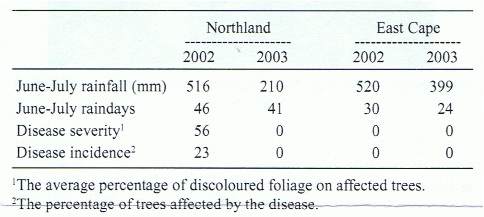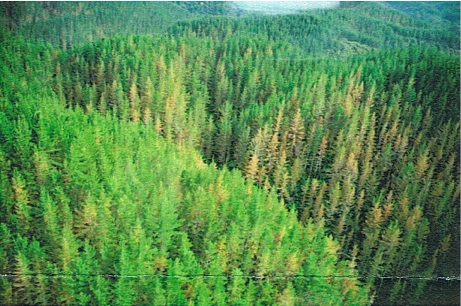PESTS AND DISEASES OF FORESTRY IN NEW ZEALAND
Episodic Defoliation (Physiological Needle Blight) of Pinus radiata
Scion is the leading provider of forest-related knowledge in New Zealand
Formerly known as the Forest Research Institute, Scion has been a leader in research relating to forest health for over 50 years. The Rotorua-based Crown Research Institute continues to provide science that will protect all forests from damage caused by insect pests, pathogens and weeds. The information presented below arises from these research activities.
From Forest Health News No. 145, October 2004.
Severe defoliation of Pinus radiata during late winter and spring has been recorded in a number of locations throughout New Zealand for over 20 years, and for convenience has been referred to by the designation "Strasseria" (FHNews 123: 1). The foliage on affected trees is discoloured yellow-brown or red-brown. Symptoms first appear in the lower part of the crown, but may spread to encompass almost the entire tree. The effect is dramatic, and affected trees can be recognised from at least 500 m. At this distance the symptoms resemble those of Dothistroma needle-blight, although they are expressed at a different time of year. Outbreaks occur intermittently and have been recorded in many parts of Northland and Auckland, in a number of forests in the Gisbome biogeographic region, in some West Coast stands, in Southland, and occasionally in the central North Island.
 A number of factors associated with the disorder have been observed. Defoliation is relatively uncommon or absent on younger trees, whereas symptoms are found predominantly on trees aged from 15 to 25 years. Affected trees may occur throughout stands of this age class, but the most severely diseased are in gullies or on ridges prone to mist. Examination of Forest Health database records (1970 to 2003) and Forest Health survey reports (1990 to 1998) revealed a possible relationship between needle death and higher than normal June-July rainfall, when temperatures were high in one month or both. To test this association, two regions where the disorder has been most often recorded were surveyed in 2002 and 2003, and climate data were gathered for comparison. Results are given below.
A number of factors associated with the disorder have been observed. Defoliation is relatively uncommon or absent on younger trees, whereas symptoms are found predominantly on trees aged from 15 to 25 years. Affected trees may occur throughout stands of this age class, but the most severely diseased are in gullies or on ridges prone to mist. Examination of Forest Health database records (1970 to 2003) and Forest Health survey reports (1990 to 1998) revealed a possible relationship between needle death and higher than normal June-July rainfall, when temperatures were high in one month or both. To test this association, two regions where the disorder has been most often recorded were surveyed in 2002 and 2003, and climate data were gathered for comparison. Results are given below.
During the period of the survey there was one outbreak in Northland, which was accompanied by high rainfall (516 mm) and frequent raindays (46 days). No such outbreak was seen in the East Cape region after a similar amount of rain fell. However, at this location there were fewer raindays, and 44% of the total June-July rainfall fell on just 3 days, suggesting that symptom expression was associated only with sustained precipitation.

It was thought initially that fungal infection was responsible for the disorder, but no clear candidate pathogen has been found. In experimental studies in which trees were constantly misted to maintain a permanent film of water on the needles, significant changes in needle condition were not seen until 8 weeks after treatment commenced. Prolonged periods of needle wetness led to needle death in the absence of the fungi that were suggested as possible causal agents. Applications of broad-spectrum fungicide did reduce the incidence of needle death, but all fungi found in or on the needles were known saprophytes. Strasseria geniculata was not among these fungi.
In summary, the hypothesis that outbreaks are a consequence of above average rainfall and raindays in June and July has been supported by the findings of aerial surveys undertaken in the last 2 years. Experimental work has indicated that the disorder is physiological in origin although the exact nature of the needle breakdown is not clear. It is likely that saprophytic fungi may accelerate the death of severely stressed needles.
(Margaret Dick and Lindsay Bulman, Forest Research)
This information is intended for general interest only. It is not intended to be a substitute for specific specialist advice on any matter and should not be relied on for that purpose. Scion will not be liable for any direct, indirect, incidental, special, consequential or exemplary damages, loss of profits, or any other intangible losses that result from using the information provided on this site.
(Scion is the trading name of the New Zealand Forest Research Institute Limited.)

 Farm Forestry New Zealand
Farm Forestry New Zealand

